Physical Address
304 North Cardinal St.
Dorchester Center, MA 02124
8.1
8.2
8.3
8.4
8.5
8.6
8.7
8.8
Visit Expert Consult ( expertconsult.inkling.com ) for videos on topics discussed throughout the text.
Ptosis is one of the most common oculoplastic problems that you will see in your office. The concepts are simple. The symptoms relate to loss of the peripheral visual field. Rarely, in severe cases, your patient may lose central vision. The majority of patients with ptosis have either congenital ptosis , caused by a dystrophy of the levator muscle, or involutional ptosis , related to aging changes in the levator aponeurosis and muscle. You can assume that your patient has one of these two types unless a finding in the history or physical examination points to an unusual type of ptosis . We approach this chapter from that perspective.
The severity of the ptosis and the best treatment are easy to determine by measurement of the eyelid vital signs. The treatment is almost always surgical, and most patients appreciate the improvement in their vision. Complications of ptosis repair are rare. Once you have experience, it becomes easy to get a good result in most patients, but it continues to be a challenge throughout your career to get a perfect result in all patients.
This chapter begins with a discussion of the normal eyelid anatomy and function. The two common forms of ptosis, simple congenital ptosis and involutional ptosis, are discussed next. The importance of the levator function in recognizing the type of ptosis and choosing the appropriate treatment becomes clear. In the sections on the history and physical examination, you learn about the findings that identify the type of ptosis and direct the appropriate surgical treatment, and you begin to recognize factors that could lead you to refine or alter your usual surgical plan. Treatment of ptosis involves an operation for tightening a relatively normal muscle using an anterior approach or a posterior approach. The anterior approach is through the skin crease and tightens the levator muscle or aponeurosis directly. The posterior approach tightens the levator muscle complex indirectly by removing the conjunctiva and Müller’s muscle from the posterior surface of the eyelid. If the levator muscle is very weak, as demonstrated by its markedly reduced function, a frontalis sling operation is required. This procedure connects the eyelid to the eyebrow with a suture, silicone rod, or piece of fascia. The natural but inefficient lift of the eyebrow using the frontalis muscle is strengthened. The details of these procedures follow the discussion of the history and physical examination. Finally, you are introduced to the numerous unusual types of ptosis.
As I have emphasized before, it is important to appreciate the normal before moving on to the abnormal. Spend some extra time learning the concepts related to the two common types of ptosis. Doing so may prevent you from missing the unusual type that you are much less likely to see.
My understanding and treatment of ptosis come from the first 25 years of my practice, where I performed the levator aponeurosis operation on the majority of my involutional patients. This approach, specifically paying close attention to the levator function, provides a valuable understanding of eyelid physiology and disease. In the past few years, I have started using the posterior approach operation (conjunctival Müller’s muscle resection [CMMR]) frequently for most involutional ptosis patients. This represents a major change in ptosis treatment for me. We talk about the use of phenylephrine (Neo-Synephrine) drops as a guide in selecting this operation, making the measurement of levator function slightly less important in the decision-making process. However, I suggest that you become a careful observer of the movement of the eyelid as an important part of your complete understanding of ptosis and eyelid function as a whole.
The upper lid rests at or just below the upper limbus. The lower lid normally sits at the lower limbus. The palpebral aperture is the distance between the upper lid margin and the lower lid margin. The normal measurement is approximately 9 mm. The position of the upper lid is best quantified as the upper lid margin reflex distance ( MRD 1 ). This measurement extends from the central corneal light reflex to the upper lid margin and is normally 4 to 5 mm ( Figure 8.1 ).
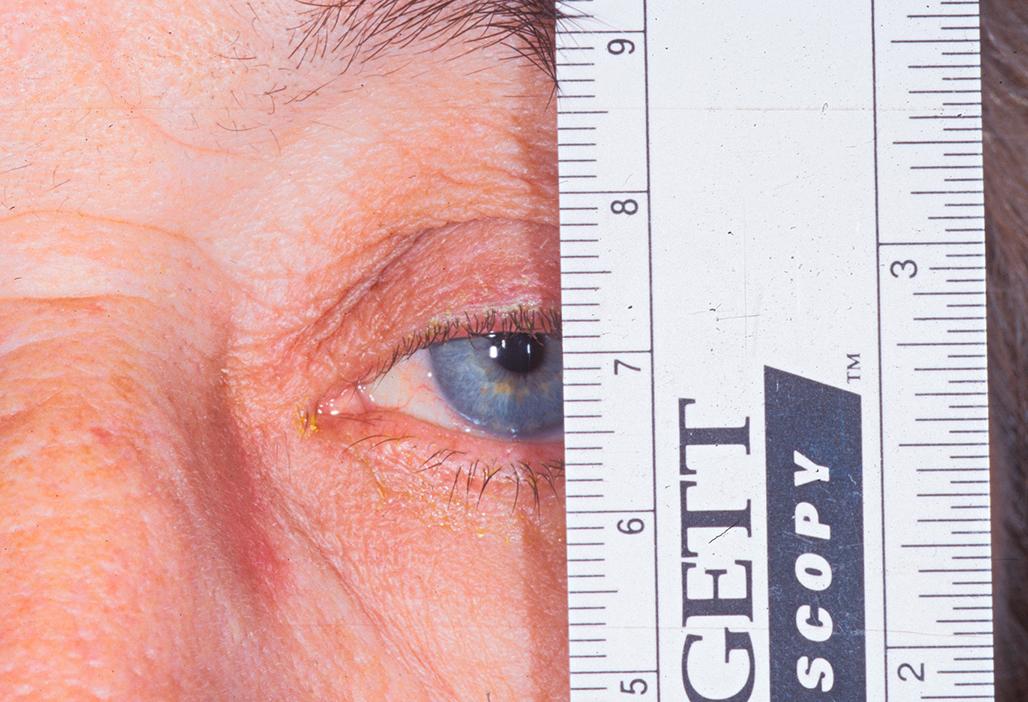
The retractors open the upper eyelid. The retractors are:
The levator muscle
Müller’s muscle
The frontalis muscle
Functional or anatomic abnormalities in the levator muscle complex are the cause of most cases of ptosis.
The levator muscle is the primary retractor of the upper eyelid. This skeletal muscle is responsible for voluntary elevation of the upper eyelid. Innervation to the levator muscle is via the superior division of the third cranial nerve (oculomotor nerve). The levator muscle originates at the orbital apex and extends forward inferior to the bone of the orbital roof ( Figure 8.2 ). At the orbital aperture, the levator is supported by Whitnall ’ s ligament (see Figure 2.22 ). As the levator muscle travels anteriorly, it becomes a fibrous aponeurosis that extends inferiorly into the eyelid to insert on the anterior aspect of the tarsal plate. The muscle fibers of the levator extend inferior to Whitnall’s ligament in most eyelids. The line where the fibrous aponeurosis merges into the muscle is a useful landmark for me in the anterior ptosis operation. I make my first attempt at correcting the eyelid height with the suture passed through this junction. This position often gives an appropriate eyelid height; more is said on that later. Fibrous extensions of the aponeurosis pass through the orbicularis muscle to create the upper eyelid skin crease ( Figure 8.3 ).
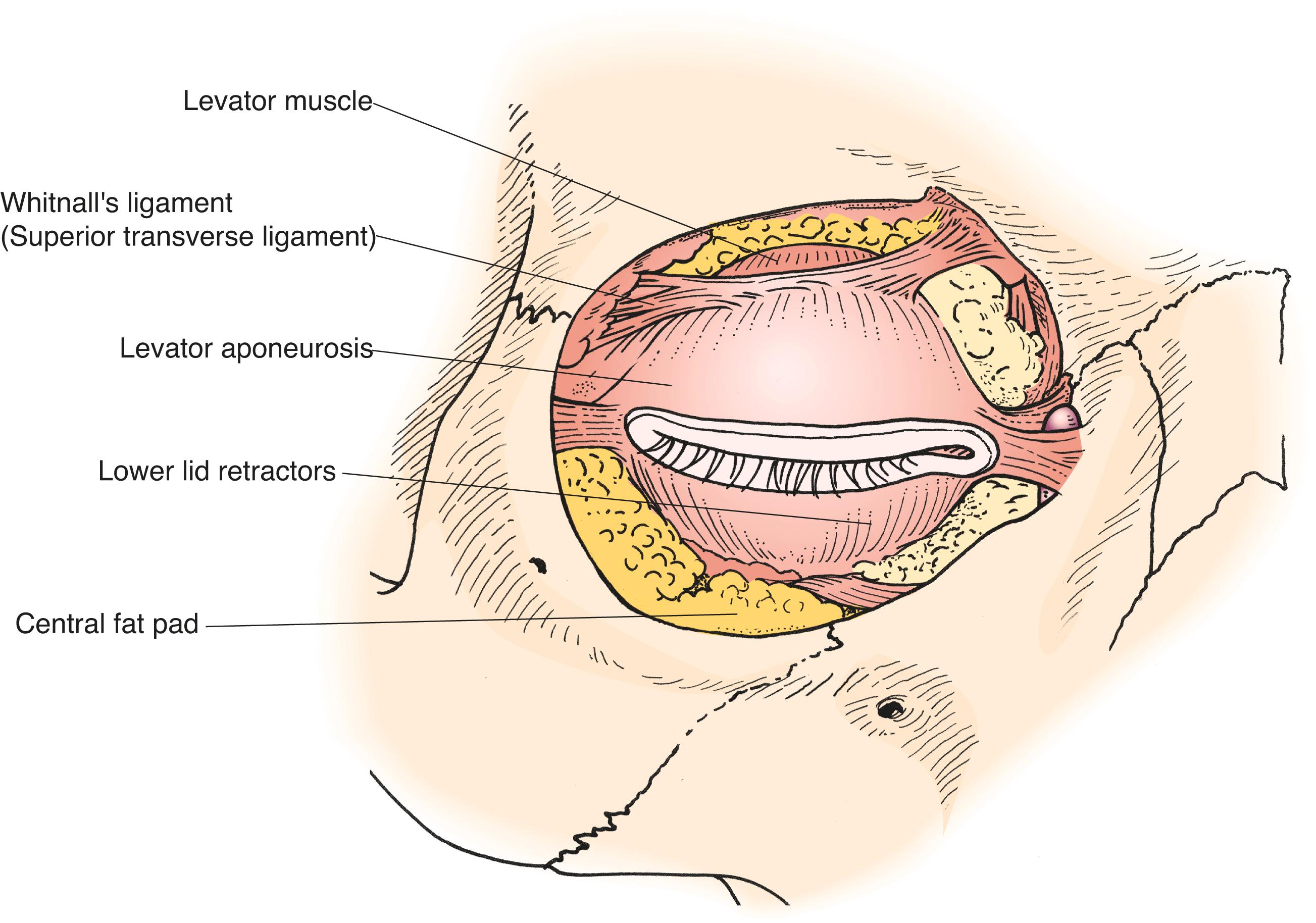
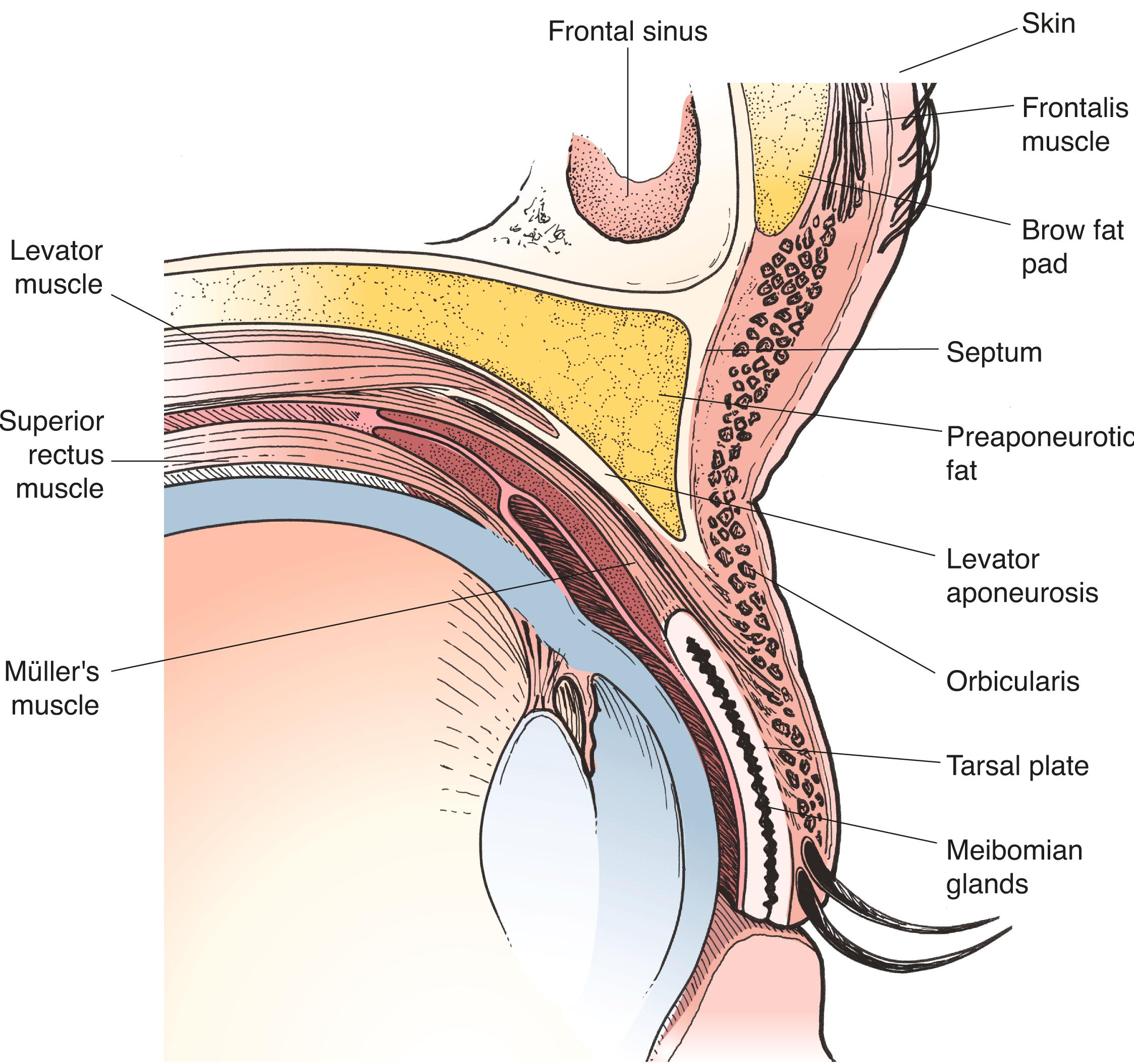
Whitnall’s ligament is an important anatomic landmark. The ligament extends from the fascia surrounding the lacrimal gland temporally to the trochlea medially. Whitnall’s ligament is usually easy to see intraoperatively as a strong white band of fibrous tissue. Generally, the tissue superior to the ligament is muscle and the tissue inferior to the ligament is aponeurosis, although variation exists among individuals. It has been suggested that Whitnall’s ligament serves as a pulley for the levator muscle. Although the levator muscle complex does not slide through the ligament, the concept of the ligament allowing the muscle to change direction is a helpful one.
As the levator aponeurosis travels from Whitnall’s ligament to the tarsus, it fans out to form the horns of the levator aponeurosis. The horns are the medial and lateral flared extensions of the aponeurosis inserting into the medial and lateral canthal regions. During operations on the levator, you see that the lateral horn of the aponeurosis is much thicker and stronger than the medial horn. The lateral horn is cut, or released, from the lateral orbital rim to improve the typical temporal flare of the upper eyelid retraction in thyroid eye disease.
Müller’s muscle is responsible for the involuntary upper eyelid elevation seen in the sympathetically innervated fight or flight phenomenon. The muscle is sandwiched between the conjunctiva posteriorly and the levator aponeurosis anteriorly. Müller’s muscle extends from the superior margin of the upper tarsal plate to where the levator aponeurosis fuses with the levator muscle (inferior to Whitnall’s ligament) (see Figure 8.3 ). A prominent surgical landmark on the surface of Müller’s muscle is the peripheral arcade, a vascular arcade extending across the muscle a few millimeters above the tarsal plate ( Figure 8.4 ; see also Figure 2.26 ). The loss of innervation to Müller’s muscle results in the mild ptosis associated with Horner syndrome.
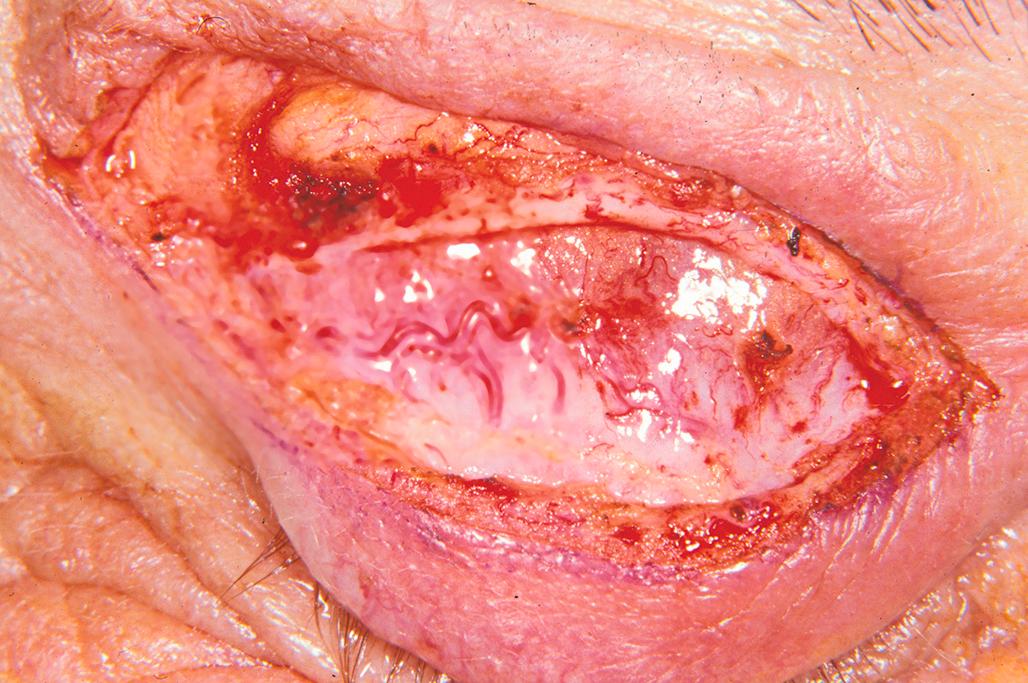
No doubt you have patients with drooping upper lids who lift their eyebrows to provide a tiny bit more upper eyelid elevation. The frontalis muscle lifts the brows and is a weak retractor of the upper eyelids ( Figure 8.5 ). The muscle is part of the galea aponeurotica of the scalp. Superiorly the frontalis becomes a fibrous aponeurosis that extends to the occipitalis muscle on the posterior surface of the skull. The point at which the frontalis muscle fuses with the aponeurosis superiorly is apparent because the forehead furrows seen with frontalis action stop at that point. Like the other muscles of facial expression, the frontalis muscle is innervated by a branch of the facial nerve, the temporal branch (also called the frontal branch ) (see Figure 2.32 ). Elevation of the eyebrows and prominent forehead furrows seen in a patient with ptosis tell you that the drooping lids are interfering with the patient’s vision. In some patients, a brow ache occurs with extended brow activity. The action of the frontalis muscle should be blocked with your thumb when making measurements of the eyelids ( Figure 8.6 ).
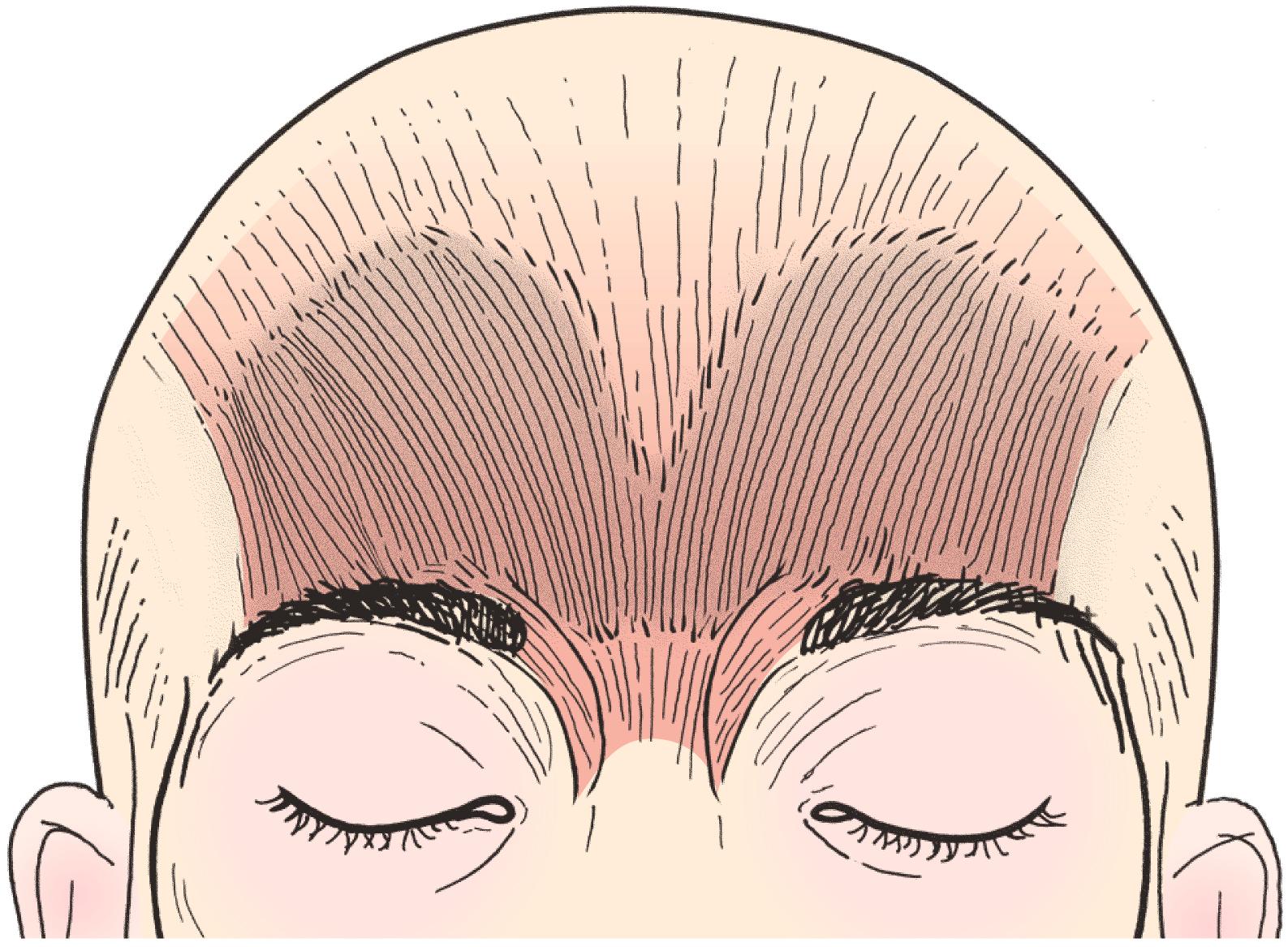

The condition or health of the eyelid can be identified by measuring the eyelid vital signs :
Margin reflex distance (MRD)
Levator function
Skin crease height and depth
Amount of upper eyelid skin
We have already mentioned the MRD as a simple way to measure the height of the upper lid. The most practical measure of the strength of the levator muscle is the levator function. The levator function is defined as the excursion of the upper lid from extreme downgaze to extreme upgaze measured in millimeters. This movement is normally 15 mm. The upper eyelid skin crease is created by the pull of the levator aponeurosis on the skin. The skin crease height is the distance from the lid margin to the crease. This height varies among individuals but averages 6 to 8 mm for men and 8 to 10 mm for women at the highest point. The crease slopes both medially and laterally. A weak levator muscle creates less pull on the skin so that the crease is less distinct or weak. The skin measurement gives you an idea if saggy eyelid skin is actually extra skin or the result of a droopy eyebrow (or a bit of both). Read this paragraph again.
The vital signs give you the information that you need to know to classify and treat ptosis and manage the fullness of the skin fold. The following concepts are repeated several times in this chapter:
Simple congenital ptosis is associated with decreased levator function.
Involutional ptosis is associated with normal levator function.
If levator function is normal, a shortening of the aponeurosis/muscle works well to lift the upper lid (levator aponeurosis advancement [LAA] operation). In most cases, a resection of the conjunctiva and Müller’s muscle (CMMR) works also.
If the levator function is poor, the eyelid is surgically connected to the brow (frontalis sling operation). The action of the frontalis muscle lifts the upper eyelid.
The levator function is important. As you become experienced in taking care of patients with ptosis, you realize that asking “What is the levator function?” becomes the critical question in terms of diagnosis and the approach to ptosis repair ( Box 8.1 ). We discuss this further in the next section.
Name the retractors of the upper eyelid.
What are the eyelid vital signs? What are the normal measurements? Remember these findings indicate the health of the upper eyelid.
What are the two most common types of ptosis?
Which of the vital signs determines the treatment of ptosis?
The status and health of the upper lid are measured by the eyelid vital signs:
Margin reflex distance (MRD)
Levator function
Skin crease height and strength
Amount of upper eyelid skin
The MRD describes the eyelid position:
The MRD 1 measures the distance from the central light reflex to the upper lid margin.
The normal value is 4 to 5 mm. The upper eyelid margin sits just inferior to the limbus.
Levator function is an indicator of the strength of the levator muscle:
The levator function is the amount of movement of the upper eyelid from downgaze to upgaze.
The normal value is 15 mm.
The upper lid skin crease is formed by the pulling of the levator aponeurosis from beneath the skin:
The position and strength of the upper lid skin crease help in recognizing the amount of levator function present and the type of ptosis.
In involutional ptosis, the crease is high and pulls diffusely.
In simple congenital ptosis, the crease is not well defined and there is reduced pull.
Proper placement of the crease during surgery is important for symmetry and an optimal surgical result.
An asymmetric high skin crease gives the appearance of a ptosis (one cause of pseudoptosis).
The measurement of upper eyelid skin is useful to determine if a blepharoplasty is necessary:
The normal eyelid skin should measure at 20 to 25 mm from the eyelid margin to the transition of the eyebrow skin.
If the skin fold appears redundant and
More than 25 mm of tissue is present, a blepharoplasty is helpful with ptosis surgery
Less than 25 mm of tissue is present, a ptotic eyebrow may be playing a part in the redundant-appearing skin fold
A blepharoplasty operation should leave symmetric amounts of skin measuring at least 20 mm.
There are many types of ptosis and many systems that classify the types ( Box 8.2 ). From a practical point of view, most patients have either simple congenital ptosis or involutional ptosis . Most of the children have simple congenital ptosis. Most of the older adults have involutional ptosis. I group the other less common types into the category unusual ptosis . This is an oversimplification, but it works well.
Simple congenital ptosis
Involutional ptosis
Unusual ptosis
For this approach to work, you must learn the common types of ptosis well. Most of our medical training is spent learning the details of diseases that we rarely see, an example being ptosis secondary to myasthenia gravis. For now, I emphasize the two common types of ptosis. After you know all about these two types, you are able to easily identify an unusual type of ptosis when you see something that does not fit with the two common types.
Levator function is the key concept in ptosis classification and treatment. We have already stated that levator function is defined as the movement, or excursion, of the eyelid from extreme downgaze to extreme upgaze. It is measured in millimeters, with 15 mm being the average normal adult measurement ( Figure 8.7 ). The levator function is the most clinically useful indicator of the health of the levator muscle. Normal movement suggests that the levator muscle has normal strength ( Box 8.3 ). As we have said, the levator function forms the basis of both the classification and treatment of ptosis. Does the patient have normal levator function? Is the levator function reduced? Is it poor or absent?
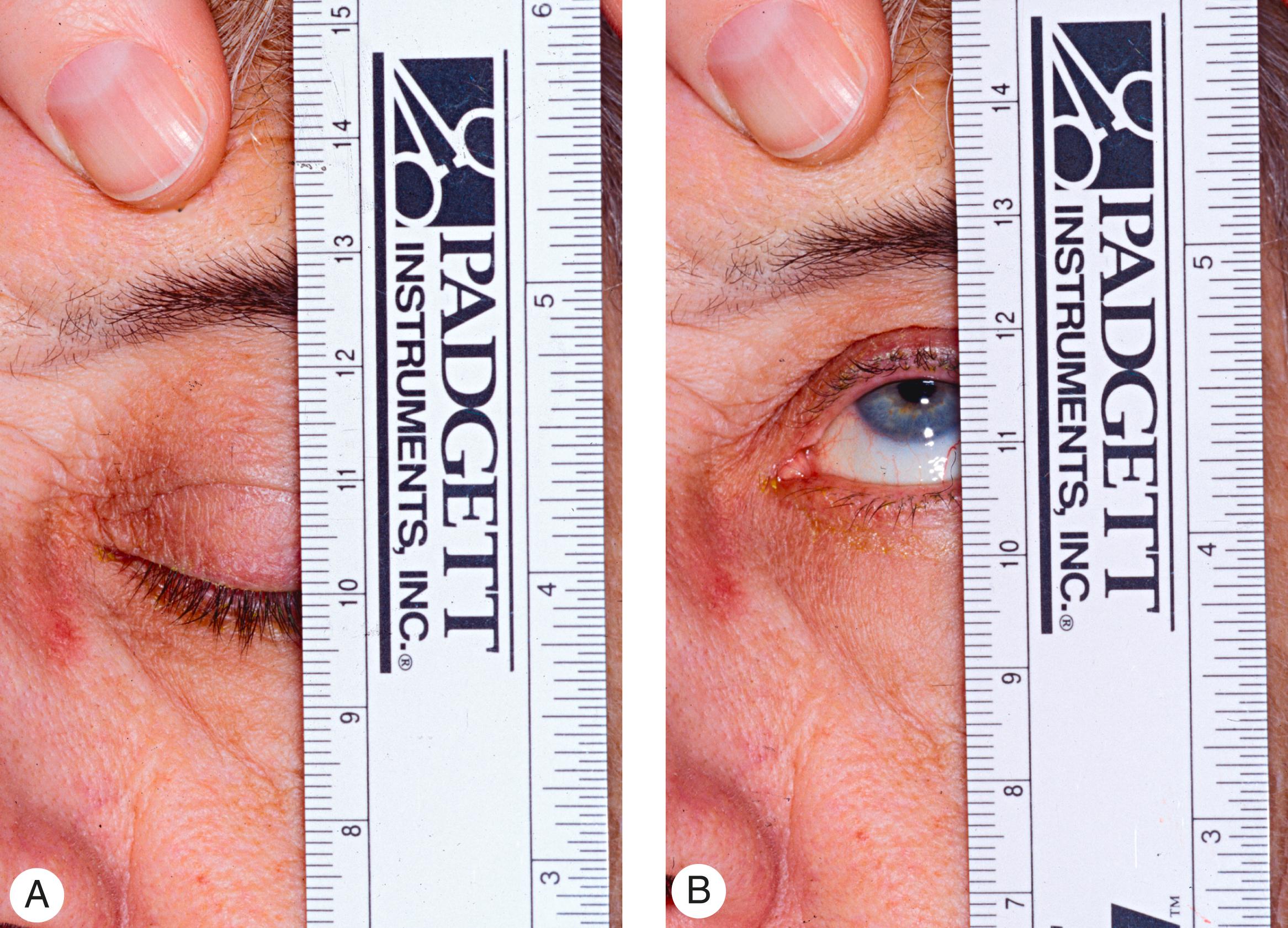
Levator function is the basis of both the classification and treatment of ptosis. The extremes are:
Normal levator function
Seen in involutional ptosis
Two choices for treatment: CMMR (posterior approach operation) or LAA (anterior approach operation)
Reduced levator function
Seen in simple congenital ptosis
Treatment: LAA if levator function is 3 to 4 mm or more; frontalis sling operation if levator function is 3 mm or less
Simple congenital ptosis is always associated with reduced levator function. If you see a child with ptosis and normal levator function, something does not make sense, and you should consider another diagnosis. Involutional ptosis is associated with normal (or near normal function). If you see an adult with ptosis and reduced levator function, something does not make sense, and you should consider another diagnosis. Are you getting the idea? So far, we know that:
Simple congenital ptosis is associated with reduced levator function.
Involutional ptosis is associated with normal or near normal levator function.
Unusual types of ptosis are usually associated with reduced levator function, but levator function also can be normal.
When I see a patient with ptosis, I classify the ptosis into one of these three categories. Most patients have involutional or simple congenital ptosis. Congenital ptosis is much less common than the acquired forms of ptosis; consequently, the majority of patients you see have involutional ptosis. By definition, the children that you see do not have involutional ptosis (they are not old!). But you may see an adult that has had a simple congenital ptosis his or her whole life and is only seeking attention for it at this point.
Look at Figure 8.8 . A man in his 50 s presents with ptosis. The ptosis is severe and the function is reduced. This is not the typical involutional ptosis. In your history you ask how long the ptosis has been present, and he tells you it has been present since birth. Ah, the diagnosis is a simple congenital ptosis appearing in an adult. I hope that this simplified system is starting to become clear. As you get more experience it is even clearer. You walk into the room, and from across the room you see a middle-aged patient with severe ptosis and a weak or absent skin crease. That appearance tells you the levator function is poor. You think, this is not the typical involutional ptosis. Maybe he has some strange ptosis that is one of the many different unusual types of ptosis. You have yet to ask a question or touch the patient. Your first question is about how long the ptosis has been present. He tells you he has had it all his life. In the first few seconds, you have a presumptive diagnosis. Your further history and examination confirm the diagnosis of simple congenital ptosis.
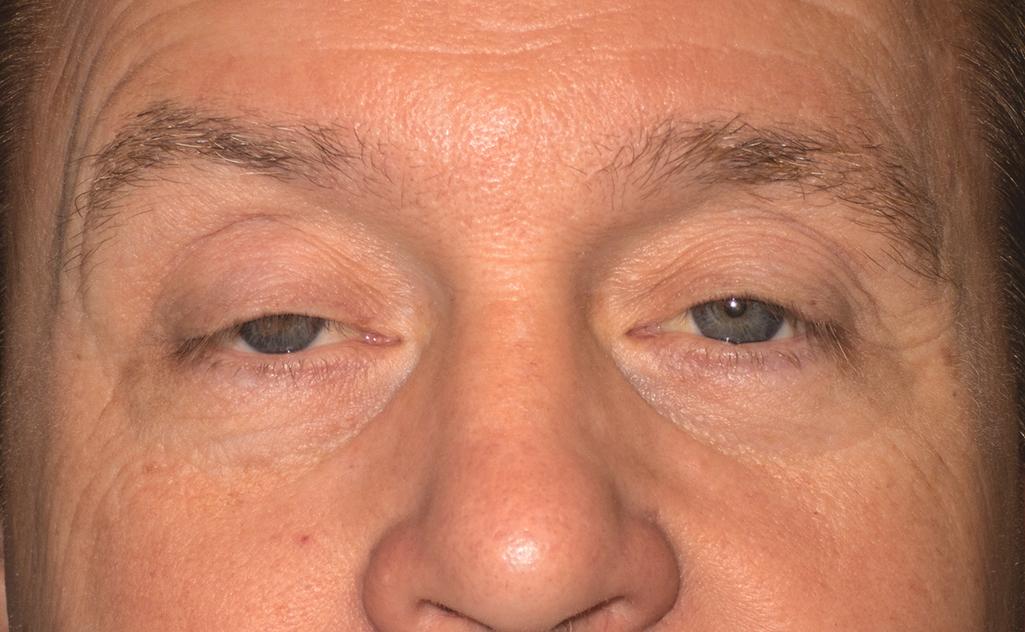
A short diversion here: My goal throughout the book is to help you develop a logical system for diagnosing and treating disorders. Like everything in medicine, it does get easier with experience. The goal is understanding. Speed is not of the essence; accuracy is. You do things faster in the clinic and the operating room as you get experience. Learn to be accurate and technically excellent first.
Remember, your examination starts as you enter the examination room. Does your patient hold one or both eyebrows up? Are there lots of horizontal forehead wrinkles from chronic eyebrow elevation? Does your patient lift his or her chin up to see? As you start to ask questions, watch how the face changes as the patient relaxes. We can all lift our eyes open when we are alert or excited. You want to see how the patient looks without making an extra effort to open the eyes ( Figure 8.9 ).

Similarly, as you measure the levator function, you must immobilize the eyebrow so that the action of the frontalis muscle is eliminated completely. The amount of movement is measured with a millimeter ruler placed next to the patient’s eye. The measurement is straightforward with adults but may be difficult with children, who often elevate the chin as well as the eyes. It is sometimes helpful to practice a few times with the child before actually measuring the function. I often demonstrate on myself to give the child the idea. Using the example of a rocket ship blasting off helps to hold the child’s attention. Several measurements should be made until a reliable number can be obtained.
Watching how the lid crease develops with lid elevation gives a good idea of the function, as well. As you get experience with measuring levator excursion, you notice that the speed of elevation also varies among individuals. Later in the chapter, we talk more about how levator function plays a role in the treatment choice. At this point, we discuss simple congenital ptosis and involutional ptosis in detail.
Let’s start with some comments on nomenclature . There are many ways to classify ptosis. Each has its own advantages. Some classification systems include congenital and acquired ptosis as the major categories. Obviously, congenital ptosis means that the patient was born with a drooping lid and acquired ptosis means that the ptosis developed after birth. Unfortunately, so many varied types of ptosis fit into these two categories that you are not given any direction for a treatment plan using this classification. To avoid confusion with the inclusive term congenital ptosis , I like to use the term simple congenital ptosis to describe a specific form of ptosis present at birth. For the most common form of acquired ptosis that occurs later in life, I like to use the term involutional ptosis ( Box 8.4 ).
Almost always bilateral, often asymmetric
Ranges from mild to severe
Reduced levator function
Weak or absent skin crease
Lid lag on downgaze
Often bilateral, can be asymmetric
Ranges from mild to severe
Normal levator function
High skin crease
Lid drop on downgaze
In simple congenital ptosis, the eyelid is ptotic because of a dystrophy of the levator muscle itself. I use the term simple to specify that the only problem is the dystrophic levator muscle. Some forms of congenital ptosis have other eye or physical findings associated. In my classification system, these cases fall into the special category unusual ptosis. Often, the associated findings dictate the treatment. When you perform ptosis surgery on a patient with simple congenital ptosis, you see that the dystrophic muscle is infiltrated with fatty tissue. The muscle is no longer a healthy red color but is yellowish to a variable degree ( Figure 8.10 ). This weak muscle cannot move well so the levator function is reduced. Usually, the degree of ptosis is related to the levator function, that is, the lower the levator function, the more ptosis is present. In patients with severe ptosis, the levator function may be totally absent. In patients with mild ptosis, the levator function may be minimally reduced.
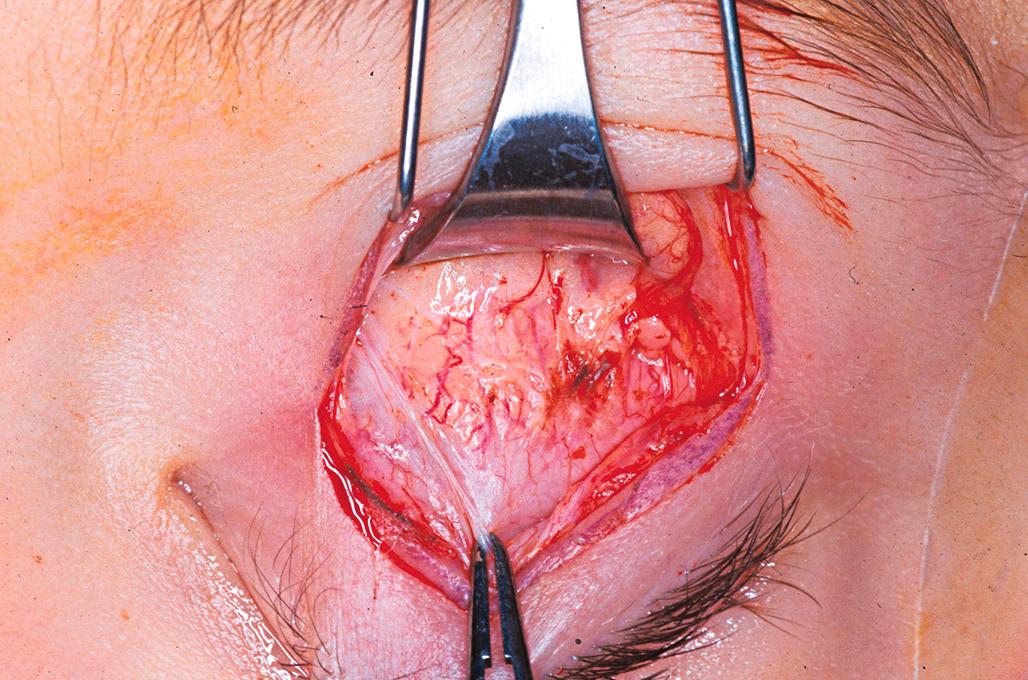
As alluded to above, reduced levator function is associated with a weak or absent skin crease. Remember that the skin crease is formed by attachments of the levator aponeurosis extending through the orbicularis to the skin at or near the top of the tarsal plate. If the levator is not pulling well, the skin crease is likewise not as well defined.
Although we usually think of the upper lid as not moving up well, it is probably more accurate to think of the weak and fibrotic muscle not moving well in either upgaze or downgaze. A characteristic of congenital ptosis demonstrating this is known as lid lag on downgaze ( Figure 8.11 ). It is important to point this out to parents before repair because shortening of a fibrotic muscle decreases the already reduced eyelid movement in downgaze, so there is more lid lag.
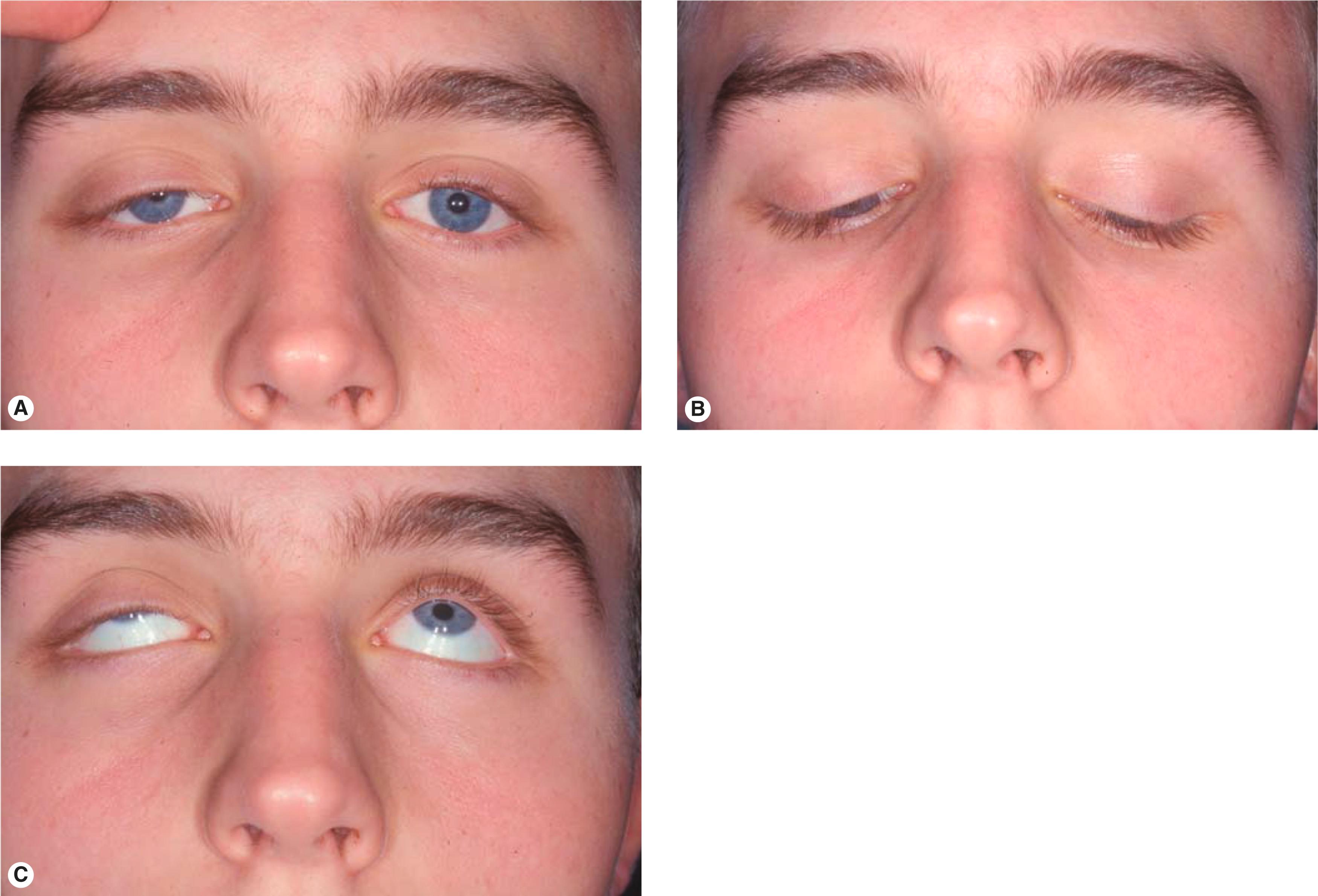
Simple congenital ptosis ranges from mild to severe. In essentially all patients with congenital ptosis, the problem is bilateral. Sometimes, the amount of ptosis is quite asymmetric, and parents are only aware that one side droops (see Figure 8.11 ). It is worth pointing out the bilaterality because it often affects some of the subtleties of the treatment.
Typically, simple congenital ptosis is associated with:
Reduced levator function
A weak or absent skin crease
Lid lag on downgaze
We have stressed that levator function is the key to both classification and treatment of ptosis. For simple ptosis with levator function greater than 4 mm, a levator aponeurosis advancement (LAA) is the usual treatment. Greater amounts of advancement are necessary for diminishing amounts of function. With large advancements, all of the aponeurosis is resected and some levator muscle is advanced. Generally, this is still referred to as a levator aponeurosis advancement in this text, but more correctly it should be termed a levator muscle resection. If the levator function is less than 3 mm, a frontalis sling procedure is appropriate. For levator function between 3 and 4 mm, a generous advancement is usual, with the resection extending high above Whitnall’s ligament into the muscle itself ( Box 8.5 ). Some surgeons add an excision of 1 to 2 mm of tarsus to large muscle advancements. This has not been my practice, but there may be cases where this could be helpful. It would be unusual for me to use a CMMR for congenital ptosis, the exception being a very minimal ptosis. Again, there may be a few surgeons that have found success with this procedure for congenital ptosis, but I have not.
Normal levator function
Aponeurosis advancement
Conjunctival Müller’s muscle resection
Poor levator function
Frontalis sling
In contrast to simple congenital ptosis, involutional ptosis is associated with normal, or near normal, levator function . The traditional teaching says that the levator muscle is normal. It has been suggested that the droop of the eyelid is caused by the thinned aponeurosis stretching out or separating from the tarsal plate; hence, the commonly used name aponeurotic ptosis . The term disinsertion is used, implying a slipping of the aponeurosis (disinsertion) off the tarsal plate or a thinning of the aponeurosis (dehiscence or rarefaction) itself. This pathophysiologic concept is helpful to differentiate this form of ptosis from the simple congenital form in which the muscle is weakened and much less easy to tighten surgically.
From a conceptual point of view, these features are helpful. Remember the suggested pathogenesis is that the aponeurosis is disinserted or stretched. The muscle is normal. It then makes sense that the levator function is normal . A high skin crease is the result of the levator fibers to the skin being dragged upward with the disinserted aponeurosis. The lid margin remains low throughout downgaze: lid drop on downgaze . This is caused by the eyelid being longer because of the aponeurosis disinsertion or stretching. Contrast this with the lid lag on downgaze in congenital ptosis caused by the fibrotic levator muscle.
Later, I try to convince you that this theory of an aponeurotic etiology in most adult involutional ptosis cases is wrong. When you gain experience, you see that most cases of involutional ptosis have a normal aponeurosis and often resection of the entire aponeurosis is necessary to get a near normal eyelid position. However, when taking an examination, you should realize that you are now smarter than most question writers and you should answer that the aponeurosis is the cause of involutional ptosis! Read this paragraph again; the discussion continues in more detail later!
Involutional ptosis ranges from mild to severe . It may be bilateral or unilateral . Usually there is an element of bilaterality to the ptosis if you look for it, although the patient often only complains about the more ptotic side.
Typically, involutional ptosis is associated with:
Good levator function
A high skin crease
Lid drop on downgaze
Compare the photos of the patients with simple congenital and involutional ptosis ( Figure 8.12 ) to get these points clear in your mind. Although not all patients show these features on examination, the concept is valuable. Importantly, as we discuss later, the etiology of involutional ptosis as being entirely aponeurotic is likely not accurate.
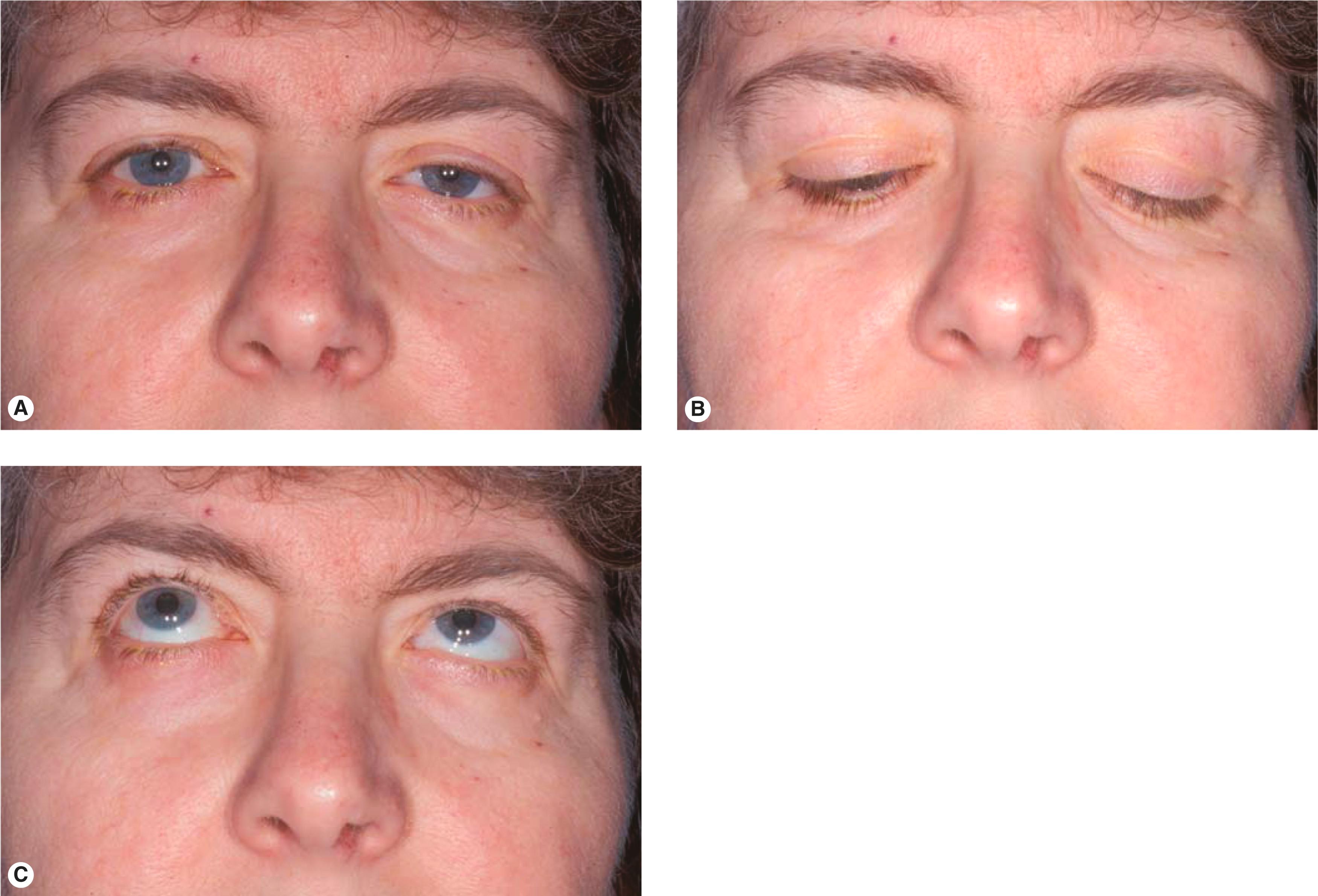
Because patients with involutional ptosis have normal levator function, tightening the levator aponeurosis is the procedure of choice. You should notice that, as long as the levator function is good, the LAA is the procedure of choice for both of the common types of ptosis.
Using our simplified classification system, what are the three types of ptosis?
What are the characteristics of the two most common types of ptosis in terms of the eyelid vital signs? Describe the physical characteristics of the levator muscle and aponeurosis that account for the eyelid vital signs associated with each ptosis type.
What is the treatment for each type of ptosis?
Your goal for the history taking and physical examination is to obtain three important pieces of information:
Identify the type of ptosis.
Formulate a treatment plan.
Identify any factors that modify the treatment.
With the background you have so far, you know that most children have simple congenital ptosis and most adults have an involutional type of ptosis. During the history taking and physical examination, look for findings that confirm the diagnosis. At the same time, look for factors that point away from the common diagnosis.
Once you have convinced yourself of the diagnosis, look for the factors that allow you to devise a treatment plan. You already know that the most important part of this is the levator function. Other factors may cause you to modify or individualize the treatment plan. Does the patient have a dry eye? Have there been other operations in the past? Is closure incomplete? Does the normal lid have an unusual contour that you may need to match? Is the patient too frail to have an operation in the usual outpatient setting? There are many of these factors, and looking for them becomes second nature with experience.
Is the diagnosis simple congenital ptosis? There are a few questions that you can ask to see if the child with ptosis has simple congenital ptosis. Remember that simple congenital ptosis involves only a ptotic upper lid in an otherwise healthy child with no other abnormal eye findings.
Is the ptosis congenital? When a ptosis is seen in a child, it is almost always congenital. Any onset after birth suggests a different diagnosis.
Is the ptosis unilateral or bilateral? Remember that congenital ptosis is usually bilateral but often asymmetric. The parents may not have recognized this. A severe unilateral congenital ptosis is at risk for amblyopia and is among the most difficult ptosis cases to treat.
Does the lid change position? Is the lid ever open all the way? Does the lid position change with eye movements? Does the eyelid position change with chewing or sucking? These findings change a suspected diagnosis of simple congenital ptosis to one of unusual ptosis; these cases are discussed in more detail soon. A diagnosis of simple congenital ptosis means that no other abnormalities are noted in the history or physical examination. You don’t need to know all the usual types at this point; just learn to recognize that there is some other associated problem.
Any ptosis is slightly worse when the patient is tired. Wide variations in the day are not typical of simple congenital ptosis.
Extreme variation of the lid position from moment to moment suggests a synkinetic form of ptosis. As the name suggests ( syn- , same; - kinesis , movement), these disorders include abnormal simultaneous movements of the lid and another muscle. Ptosis associated with abnormal lid movements caused by chewing, sucking, or other changes in jaw position is known as Marcus Gunn jaw winking. Ptosis associated with abnormal lid movements caused by changes in eye position is seen in third nerve palsy with aberrant regeneration.
Is there a family history of ptosis?
Strict inheritance of simple congenital ptosis is rare.
Occasionally, a family has several members with ptosis without any other associated abnormality.
More likely, a family history suggests the presence of blepharophimosis syndrome ( Figure 8.13A ), which consists of ptosis, epicanthus inversus, and telecanthus. The epicanthal folds and telecanthus are usually easy to recognize. The facies are usually a well-recognized family trait because of the autosomal dominant inheritance pattern. Often the parent bringing the child has the syndrome. Sporadic cases are not uncommon, however. Lower eyelid ectropion and abnormally shaped ears (lop ears) may also be present.
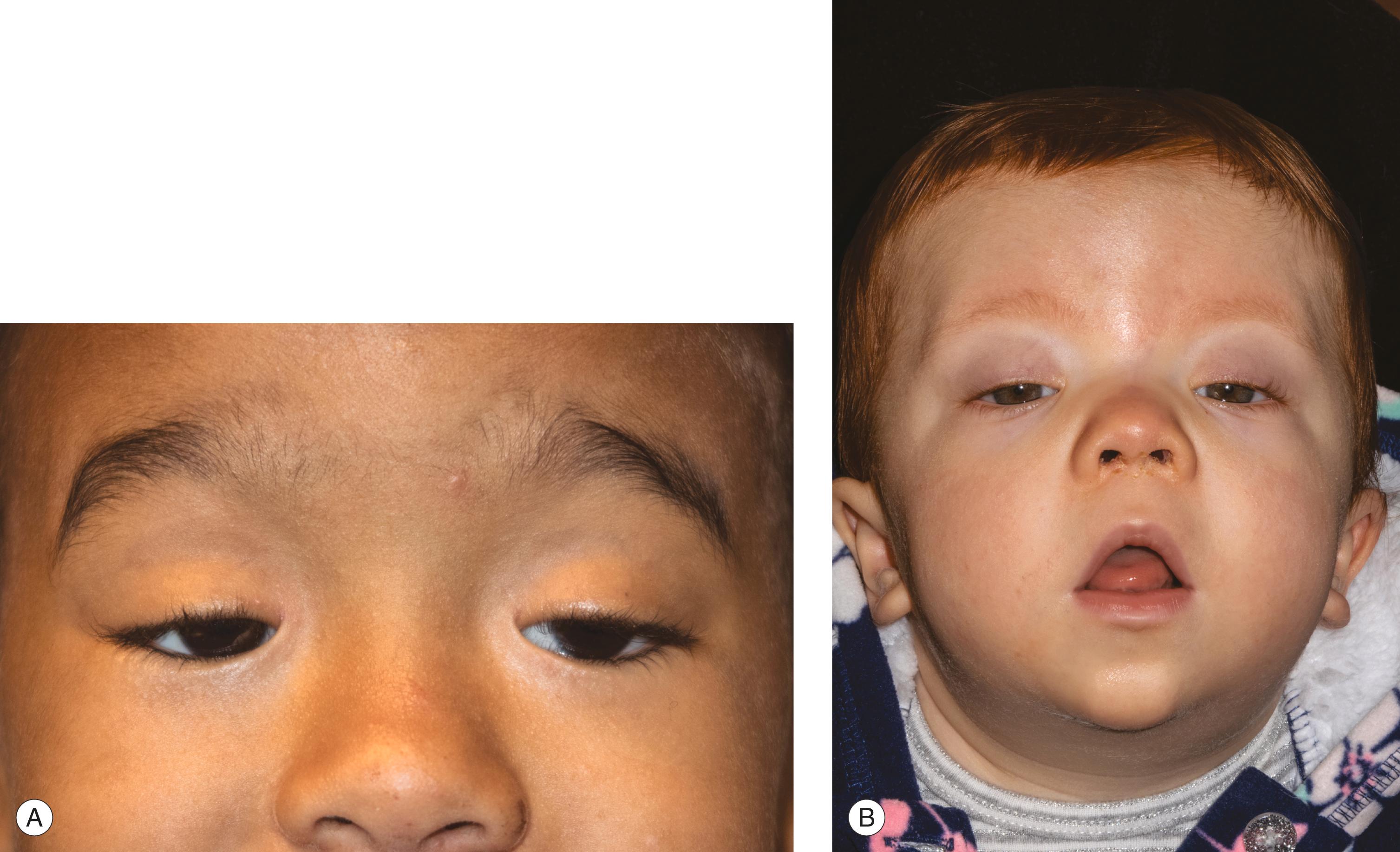
Congenital ptosis is not commonly associated with any ocular or systemic abnormalities. The dystrophy of the levator muscle is the only abnormality present. Rarely, a congenital ptosis may occur as part of a syndrome (see Figure 8.13B ). Usually, the presence of a syndrome is obvious, based upon physical or neurologic development, but questions about the child’s medical history are appropriate.
The treatment plan for a simple congenital ptosis is based mainly on diagnosis and the levator function. Your questions in the history taking help you confirm the diagnosis of simple congenital ptosis. More information about levator function appears later under Physical Examination.
Now you have a good idea that the ptosis is the simple congenital type. You are planning to repair the ptosis sometime in the future. What factors should you consider that might affect the timing or the operation that you are planning?
Is the lid open above the pupil? During what part of the day?
Surgical repair of simple congenital ptosis is usually done before the child starts school (at age 4). Features in the history suggesting the possibility of amblyopia dictate earlier intervention.
Amblyopia caused by congenital ptosis is rare. Severe unilateral ptosis is the most likely type to cause amblyopia ( Figure 8.14 ). Associated astigmatism may contribute to the amblyopia.

You should ask the parents to call you if the child stops trying to see out from under the drooping eyelid.
As children start to walk, a severe ptosis requires the child to adopt a chin-up head position (see Figure 8.13B ). This may make it difficult for the child to see what is on the floor. If this seems to be an issue, early surgery is reasonable.
A history of previous ptosis surgery makes your operation more difficult. Previous ptosis repair, especially LAA (tightening) procedures, puts the patient at risk for corneal exposure after more advancement.
By the end of the history taking, you should have an idea whether the ptosis is the simple congenital type. You should also have some idea of what operation the child needs and factors that might influence the timing of the operation. In the physical examination, you confirm your impressions ( Box 8.6 ).
Confirm diagnosis and etiology
Identify any characteristics of unusual types of ptosis
Identify factors that could modify the operation
Unilateral or bilateral ptosis since birth
No other associated eye or systemic problems
Could amblyopia be present?
How severe is the ptosis?
Is the ptosis unilateral or bilateral?
For how much time is the lid above the pupil?
Associated strabismus
Family history
Blepharophimosis syndrome
Developmental delay
Many syndromes associated with ptosis
Extreme variation of ptosis from minute to minute or throughout the day
Lid movement associated with chewing or sucking
Lid movement associated with eye movements
The goals of the history taking for an adult are the same as those for a child but are somewhat more involved because there are more unusual types of ptosis in adults. The factors that may modify the final height of the ptosis correction, such as dry eye, are often important.
The goals are to:
Determine the etiology of the ptosis
Identify any characteristics suggesting an unusual type of ptosis
Identify factors that modify the planned operation
In the adult, an additional piece of information to obtain is documentation of the effect of the ptosis on the patient’s vision.
Is the diagnosis involutional ptosis? The first part of the history taking helps you determine if the ptosis is the usual involutional type seen as the most common acquired ptosis in adults.
Is the ptosis acquired or has it been present since birth? When was the onset? What is the rate of progression?
Most adults have an acquired form of ptosis, usually the common involutional type. The onset is difficult to identify because the progression is usually so gradual over several years that no particular time can be identified as the exact onset.
An acute onset suggests a diagnosis other than involutional ptosis.
An exception to this is the onset of involutional ptosis after cataract surgery . This is uncommon today but occurred often when a superior rectus fixation suture was used in cataract surgery.
Occasionally an adult will have preexisting congenital ptosis that has slowly gotten worse over time or may have asymmetric congenital ptosis that can no longer be ignored because the normal side has progressively drooped more (see Figure 8.8 ). A review of old photos is rarely necessary because the physical examination usually confirms the reduced levator function of congenital ptosis.
Remember that any cause of ptosis in a child persists into adulthood.
The remaining portion of the history taking helps you identify factors that may cause you to modify the usual LAA procedure performed on patients with involutional ptosis. One of the main goals is to identify the patient who may develop corneal exposure if the eyelid is elevated.
Is there a history of previous ptosis operations? A history of previous lid operations may be a warning sign that the levator aponeurosis has already been shortened so that further tightening may cause lagophthalmos. Second operations tend to be more painful for the patient and technically more demanding for the surgeon.
Does the patient have symptoms of dry eye? Many dry eye patients are overdiagnosed and told to use artificial tears. A patient that gets relief with using artificial tears once a day or occasionally does not have a dry eye condition that is likely to be affected by ptosis surgery. Look for the symptoms and physical findings of dry eye. Symptoms such as burning or eye irritation with air movement across the eye are good clues to an undiagnosed dry eye condition. Frequent use of eye drops or ointments may mean that the patient has a known dry eye problem ( Box 8.7 ). Keep in mind, however, that many patients have been told that they have a dry eye when there is little to support the diagnosis. You have to make the determination on the lubrication status of the eye based on your history and examination before proceeding with any ptosis repair.
Confirm diagnosis and etiology
Identify any characteristics of unusual types of ptosis
Identify factors that could modify the operation
Indefinite onset, gradual progression
No other associated eye or systemic problems
What is the patient’s complaint?
Most commonly, visual loss
Peripheral vision: mild to moderate cases
Central vision: severe cases
Brow ache or headache may be present
Difficulty with reading, often with bifocal lens
Ptosis is usually of about the same severity throughout the day
Positive family history
Associated diplopia
Variation in degree of ptosis
Minute to minute
With eye movements
Better after naps
Associated facial movement problems
History of facial nerve palsy
History of facial spasms
Possible corneal exposure
Dry eye symptoms
Use of eye drops or ointment
Previous eye or lid operations
History of facial nerve weakness
Patient’s general health
Patient’s preference for a particular outcome
Is there a history of facial nerve palsy? A history of facial nerve palsy signals the potential for poor blinking and lagophthalmos after surgery.
What is the patient’s general health?
Is the patient taking a long list of medications? Is there an associated systemic disease? Is the patient morbidly obese? This may suggest that the ptosis repair should be done in an operating room with more supervision than in an office or an outpatient operating room.
Is the patient particularly nervous during the examination, suggesting that you would like an anesthesiologist present to help with sedation?
By the end of the history taking, you have obtained a large amount of information. You have a good idea whether the ptosis is typical of simple congenital ptosis or an involutional type. You have looked for unusual features that might suggest that this is not the usual congenital or acquired ptosis. You have started to make a treatment plan. You know how the patient’s vision is affected and have determined the goals of treatment. You have begun to identify factors that would make you want to modify the usual surgery. With this information in hand, you are ready to do the physical examination. You know what points you need to emphasize during the physical examination to confirm or deny your findings in the history taking. Like most new learning situations, a checklist can be helpful for you. With experience, the history taking becomes automatic.
As we have seen above, a good history prepares you to do a directed physical examination. As in all fields of medicine, the history and physical examination are highly complementary. The goals of the physical examination are to:
Classify the type of ptosis based on levator function.
Identify findings suggesting that an unusual ptosis is present.
Document the degree of ptosis.
Look for factors that might modify the usual ptosis operation.
The eyelid vital signs give an assessment of the overall condition of the eyelids:
Margin reflex distance (MRD)
MRD 1 and MRD 2
Levator function
Excursion from downgaze to upgaze
Speed of movement
Skin crease height and strength
Amount of eyelid skin
You should measure the eyelid vital signs in every patient with ptosis.
We used the term margin reflex distance (MRD) earlier. The MRD is a useful measurement for describing the position of the eyelids. Before the introduction of the MRD, the palpebral fissure measurement was used. This distance is the millimeters measured between the upper and lower lids. A normal palpebral fissure is 9 to 10 mm. For the palpebral fissure measurement to be meaningful in describing the upper lid position, the lower lid must be in the normal position. A fissure of 9 mm could mean that the upper lid is crossing the pupil and that the lower lid is 4 mm below the lower limbus. For this reason, the palpebral fissure, or aperture, measurement has largely been replaced by the MRD measurement.
Useful refinements of the MRD measurement are the MRD 1 and MRD 2 . MRD 1 designates the distance of the upper lid from the corneal light reflex. MRD 2 designates the distance of the lower lid from the corneal light reflex. These measurements give a good mental picture and accurately define the position of the upper and lower lids.
The MRD 1 measures the degree of ptosis. It should be measured using a penlight and a millimeter rule. With the patient at your eye level, ask him or her to look straight ahead at a distant target. Shine the penlight at the patient’s eye. The distance from the corneal light reflex to the upper lid margin, measured with the millimeter rule, is the MRD 1 . With some experience, it is easy to estimate the MRD 1 , if you assume that the corneal diameter is 10 mm and that the normal upper lid resting position is just below the upper limbus. The normal MRD 1 is between 4 and 5 mm. If the lid margin crosses the pupil, the MRD 1 is 0 mm. If the lid margin is about halfway down from the limbus to the corneal light reflex, the MRD 1 is 2.5 mm (a good number to remember because an MRD 1 of 2.0 or 2.5 is usually required by insurance companies as an indication that a visual impairment exists) ( Figure 8.15 ).
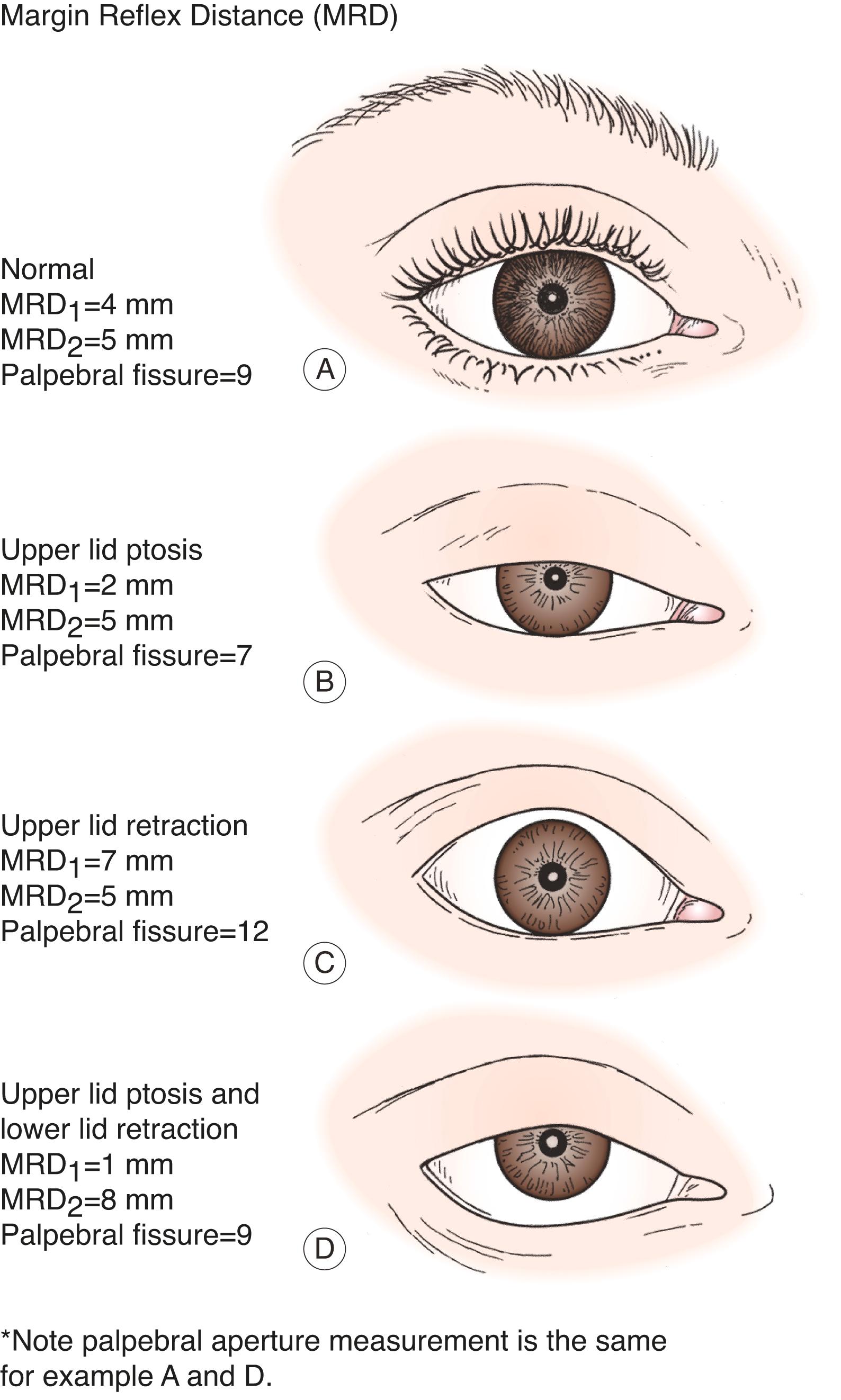
It is important to remember that the patient should be relaxed during this measurement. The frontalis muscle should not be contributing to the lid opening. As we stated earlier, it is best to neutralize the brow during this measurement. Take care not to push the lid down, however. I usually ask the patient to close the eyes and then open them in a comfortable position. Often the patient is somewhat anxious during the initial part of the examination and the eyes are open more than usual. It is important to recognize this and help the patient relax during this measurement.
With experience, it is easy to accurately estimate the MRD just by watching the patient while obtaining the history. Although for the sake of organizing this textbook, I have separated history taking and physical examination, as you probably already know, many observational measurements are made while obtaining the history. As you have probably heard before in your training, the physical examination starts when the patient walks into the examination room. Let’s look at Figure 8.16 .
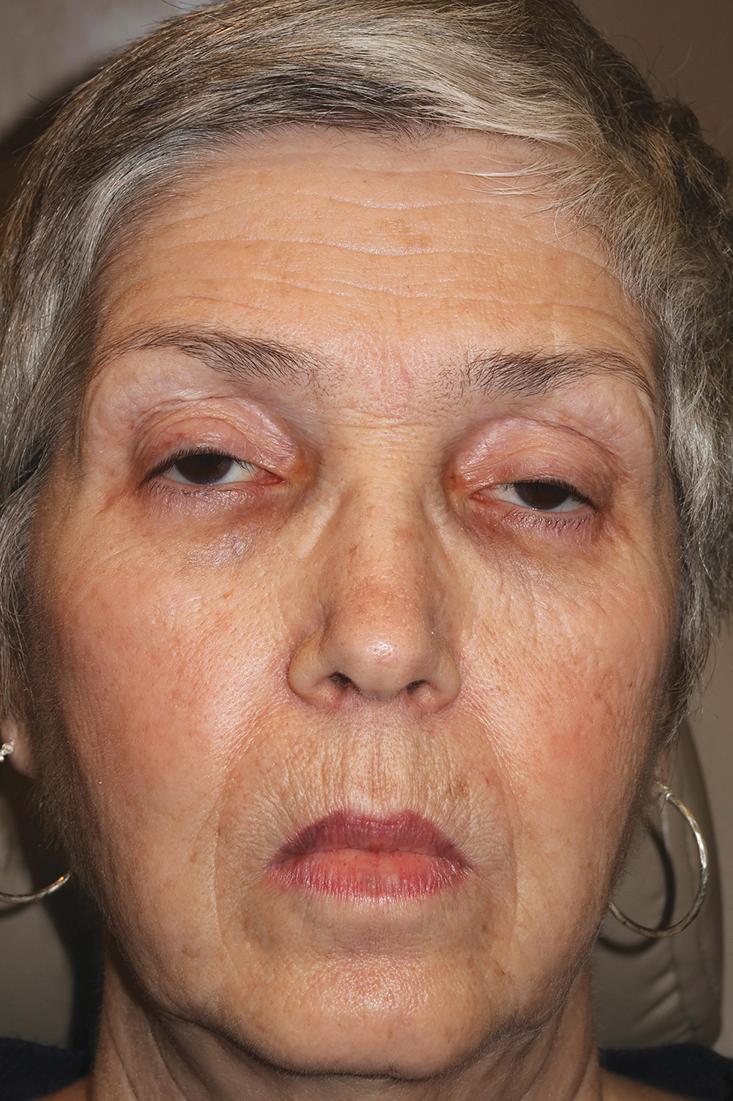
As you begin the examination, you see a middle-aged woman who uses a walker. She has bilateral ptosis. Her face has very little expression; she is probably too young for Parkinson syndrome. There is almost no facial movement of either side and appears bilaterally symmetric. It is not a bilateral facial nerve paralysis (rare); there is no droop, and the face just barely moves. It looks like an unusual ptosis, probably myogenic. This is all determined in a moment of observation. I think you are getting the idea. It turns out that this patient has an unusual form of muscular dystrophy. She has reduced levator function, a poor Bell’s phenomenon, and a poor blink. You need to consider all this before you make a plan for ptosis repair. As you gain experience, it is surprising how quickly you pick up cues to help you make the diagnosis and refine your treatment plan.
We have stressed the importance of the levator function in determining the health or strength of the levator muscle. Practice measuring the levator function in adults before you try to get accurate measurements in children. Remember to block the action of the brow with your thumb and do not allow the head to tip up with eye elevation.
The conventional levator function is a measurement of distance ( levator excursion ). I believe that it is worth considering a refinement in the measurement of levator function, an estimate of the speed of the movement. As your measurements get more accurate, you notice that the excursion of the upper lid is much slower in patients with some of the unusual types of ptosis. You realize that many involutional ptosis patients have normal or near normal excursion (12 to 15 mm) but very slow rates of eyelid elevation. This explains, in part at least, why ptosis repair is not always straightforward. A patient with an excursion of 15 mm but a very slow speed is likely to require greater levator advancement than a patient with an excursion of 15 mm but a very fast movement. Compare two runners each running a mile; the first runs a 4-minute mile and the second makes it across the finish line in 12 minutes. They have both run a mile, but do they have the same leg muscles? Observe the speed of levator excursion as an additional factor in determining the strength of the levator muscle complex (refer to Figure 8.48 ).
The distance from the upper lid margin to the skin crease is the skin crease height. In adult women, the measurement is 8 to 10 mm, and in adult men, the measurement is 6 to 8 mm. In children, the height is somewhat less.
The skin crease is important for three reasons:
It tells you about the type of ptosis.
It gives you an estimate of the levator function.
It provides the standard incision line for opening the eyelid in most ptosis operations.
You see a weak, or indistinct, skin crease in simple congenital ptosis. The weaker the levator muscle is, the weaker the crease. Any patient with reduced levator function has a weakened skin crease. You see a formed crease in most patients with involutional ptosis. In many patients, the lid crease is higher on the more ptotic side. The standard ptosis operations begin with an incision in the skin crease. This incision gives you access to the levator aponeurosis and muscle. The wounds heal with minimal scarring.
In adults, the history and physical examination are followed by photographs and visual field testing. Upon return from visual field testing the technician puts Neo-Synephrine drops (2.5%) in one or both eyes. After a few minutes, I return to evaluate the effect of the drops and discuss options for treatment. More is presented on that later.
Become a Clinical Tree membership for Full access and enjoy Unlimited articles
If you are a member. Log in here